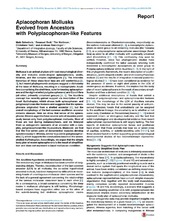| dc.contributor.author | Scherholz, Maik | eng |
| dc.contributor.author | Redl, Emanuel | eng |
| dc.contributor.author | Wollesen, Tim | eng |
| dc.contributor.author | Todt, Christiane | eng |
| dc.contributor.author | Wanninger, Andreas | eng |
| dc.date.accessioned | 2015-04-09T12:57:52Z | |
| dc.date.available | 2015-04-09T12:57:52Z | |
| dc.date.issued | 2013-11-04 | eng |
| dc.identifier.issn | 0960-9822 | |
| dc.identifier.uri | https://hdl.handle.net/1956/9735 | |
| dc.description.abstract | Mollusca is an animal phylum with vast morphological diversity and includes worm-shaped aplacophorans, snails, bivalves, and the complex cephalopods [1]. The interrelationships of these class-level taxa are still contentious [2 and 3], but recent phylogenomic analyses suggest a dichotomy at the base of Mollusca, resulting in a monophyletic Aculifera (comprising the shell-less, sclerite-bearing aplacophorans and the eight-shelled polyplacophorans) and Conchifera (all other, primarily univalved groups) [4 and 5]. The Aculifera concept has recently gained support via description of the fossil Kulindroplax, which shows both aplacophoran- and polyplacophoran-like features and suggests that the aplacophorans originated from a shelled ancestor [ 6], but the overall morphology of the last common aculiferan ancestor remains obscure. Here we show that larvae of the aplacophoran Wirenia argentea have several sets of muscles previously known only from polyplacophoran mollusks. Most of these are lost during metamorphosis, and we interpret them as ontogenetic remnants of an ancestor with a complex, polyplacophoran-like musculature. Moreover, we find that the first seven pairs of dorsoventral muscles develop synchronously in Wirenia, similar to juvenile polyplacophorans [ 7], which supports the conclusions based on the seven-shelled Kulindroplax. Accordingly, we argue that the simple body plan of recent aplacophorans is the result of simplification and does not represent a basal molluscan condition. | en_US |
| dc.language.iso | eng | eng |
| dc.publisher | Elsevier | eng |
| dc.rights | Attribution-NonCommercial-NoDerivs CC BY-NC-ND | eng |
| dc.rights.uri | http://creativecommons.org/licenses/by-nc-nd/3.0/ | eng |
| dc.title | Aplacophoran mollusks evolved from ancestors with polyplacophoran-like features | eng |
| dc.type | Peer reviewed | en_US |
| dc.type | Journal article | en_US |
| dc.date.updated | 2015-04-01T08:16:01Z | en_US |
| dc.description.version | publishedVersion | |
| dc.rights.holder | Copyright 2013 The Authors | |
| dc.identifier.doi | https://doi.org/10.1016/j.cub.2013.08.056 | |
| dc.identifier.cristin | 1093777 | |
| dc.source.journal | Current Biology | |
| dc.source.40 | 23 | |
| dc.source.14 | 21 | |
| dc.source.pagenumber | 2130-2134 | |
| dc.subject.nsi | VDP::Mathematics and natural scienses: 400::Zoology and botany: 480::Systematic zoology: 487 | eng |
| dc.subject.nsi | VDP::Matematikk og naturvitenskap: 400::Zoologiske og botaniske fag: 480::Systematisk zoologi: 487 | nob |

